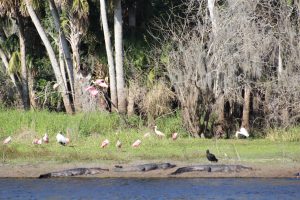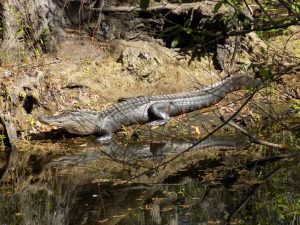Are there Alligators in Florida?
Yes indeed! The American alligator is one of Florida’s most iconic examples of native wildlife with an estimated population of 1.5 million alligators in Florida, that’s almost 1 alligator for every 20 humans!

Alligators can be found in almost any fresh or brackish water bodies throughout Sarasota, including the notable Myakka River. These native reptiles are essential to our ecosystem. They help control populations of specific species by consuming fish, turtles, birds, small mammals, and even invasive species, promoting a harmonious balance within our ecosystem. Additionally, alligators play a vital role in creating and sustaining wetland habitats through their activities, which benefit numerous other species such as threatened and endangered fish and amphibians. Because of this, they are considered keystone species, ecosystem engineers, and an indicator species of the health of wetlands such as the Everglades. Alligator numbers have rebounded since being listed as an endangered species decades ago, but they are still protected by law. It is illegal to feed, harass, possess, or kill them. Hunting is only allowed by permit from the Florida Fish and Wildlife Conservation Commission (FWC).
Mating Behavior and Florida’s Dry Season: Increased Activity

Understanding alligator behavior is crucial for their existence and minimizing interactions with them, particularly during their mating season which corresponds to our dry season. Alligator movements increase during the months of March – June as they look for mates and move from drying water bodies to larger ones in which they can submerge and find food. Courtship activities typically start in March or April, and are characterized by displays of head-slapping on the water’s surface and low-frequency vocalizations to attract females. Mating occurs from May to June, increasing the likelihood of seeing or encountering an alligator. Male alligators become territorial as they compete for mates. After mating, females will remain with their nests and will hiss or display mouth opening to fend off intruders. It is essential to exercise caution and keep a safe distance from alligators all year round, but especially during these months.
Normal Alligator Behavior

It is normal for alligators to:
- move from one body of water to another, sometimes this means crossing a road, your yard, or a golf course. Likelihood of seeing alligators on the move increases during the months of March – June, and can also be more likely during times of high rainfall or flooding.
- bask in the sun to warm up and increase their metabolism. This can occur on the banks of stormwater retention ponds, lakes, rivers, and streams as well as on areas of grass.
- move quickly into the water if they feel threatened. Alligators may make a big splash or noise getting into the water, but this is where they feel most safe.
Abnormal Alligator Behavior
It is abnormal for an alligator to show excessive interest in a human or pet by swimming directly towards you. Alligators may turn in the water or on land to look at you, but they should not directly approach you. This is a sign that they are probably associating you with an easy meal and have lost their natural fear of humans.
Nuisance Alligators
Alligators can become “nuisance gators” when they associate people with food. Feeding alligators causes them to loose their natural fear of humans and associate us with a readily available source of food. They are then more likely to approach the next adult, child, or pet that they see, putting human and pet safety at risk. Remember, “A fed gator is a dead gator”. If you encounter a nuisance alligator, report it to the FWC’s toll-free Nuisance Alligator Hotline at 1-866-FWC-GATOR (392-4286). Wildlife authorities rarely relocate alligators. This option is unlikely due to limited habitat, resources, and lack of success. In most cases, alligators are euthanized. To avoid the unnecessary use of resources or euthanasia of wildlife, call the nuisance gator hotline only if an alligator is over 4 feet in length and the caller believes it poses a threat to people, pets or property. Most communities and HOAs prefer that if you do call the FWC nuisance gator hotline, you then alert the management office in your community.

Be part of the solution!
Learn more about normal and abnormal alligator behavior and how you can make the best choices to minimize interactions with alligators, keeping yourself, your family and pets, and wildlife safe:
Watch the 30-minute alligator webinar on Sarasota Starter Kit: A Guide to Living on the Suncoast, a series that provide essential information to new and current residents of the Suncoast. You can also check out the Sarasota County Starter Kit blog series.
Webinars and further resources are available on over 140 species of wildlife (including alligators) at our Florida Wildlife webpage.
Register for Neighborhood Best Practices an online, self-paced course that provides videos, fact sheets, resource links and more on topics from wildlife interactions to preservation areas, from water quality to sustainable landscapes to foster thriving, informed, and sustainable communities.
 Join a Florida Master Naturalist Program class: an adult education program developed by the University of Florida. FMNP training benefits anyone interested in learning more about Florida’s environment, seeking educational contact hours, or wishing to increase their knowledge for use in education programs as volunteers, employees, ecotourism guides, and others.
Join a Florida Master Naturalist Program class: an adult education program developed by the University of Florida. FMNP training benefits anyone interested in learning more about Florida’s environment, seeking educational contact hours, or wishing to increase their knowledge for use in education programs as volunteers, employees, ecotourism guides, and others.
Learn more about Living with Alligators from FWC.
Other Series of Interest
“Wild Sarasota” blog series Enjoy blogs on identification, life history, and fun facts about our native wildlife.
Wild and Scenic: A Day in the Life of a Biologist on the Myakka River blog series
“Stories of Gratitude for the World of Wildlife” blog series
 1
1

